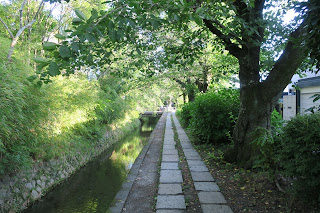The Philosopher's Walk (Tetsugaku-no-michi, lit. Path of Philosophy) is a pedestrian path that follows a cherry-tree-lined canal in Kyoto, Japan between Ginkaku-ji and Nanzen-ji.
The route is so-named because two 20th-century Japanese philosophers and Kyoto University professors Nishida Kitaro and Hajime Tanabe are thought to have used it for daily exercise.
The path passes a number of temples and shrines such as Honen-in, Otoyo Shrine, and Eikan-do Zenrin-ji.
It takes about 30 minutes to complete the walk, although many people spend more time visiting the sights along the way.
|
Philosopher's Walk map. |
|
Jodoji Kamiminamidacho Jizoson. |
|
Bougatei Novelty store. |
|
Sagan Coffee shop. |
|
Pottery store. |
|
Cafe Cherry. |
|
Daitoyo Bridge. |
|
First torii gate (Ichinotorii). |
|
Shishigatani St. map. |
Nanzen-ji Temple
|
Great Jakumon Gate (Daijaku-mon). |
|
Sanmon Gate seen from the south.
|
|
Sanmon Gate seen from the west. |
|
Sanmon Gate seen from the east. |
|
Stone lantern (Toro).
|
|
Nanzen-ji Hatto.
|
See also
-
Kyoto Gion District
-
Ryoan-ji Temple
-
Zen Buddhism
-
Kinkaku-ji Temple
-
Teramachi Shopping Street
-
Japanese Tea Ceremony
-
Kodai-ji Temple
-
Ginkaku-ji Temple
-
Nijo Castle
Source
Location

















